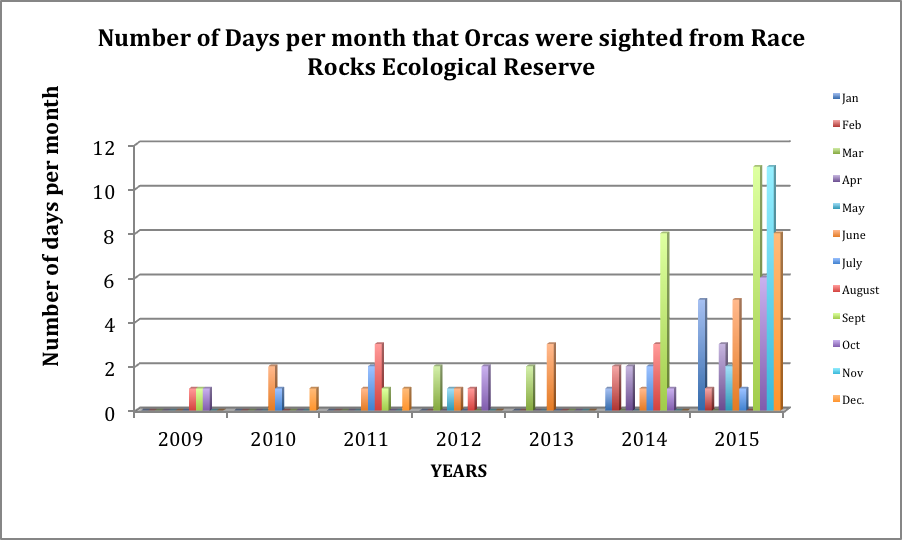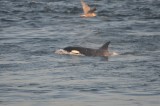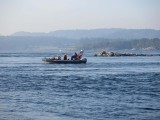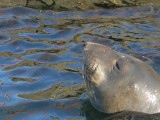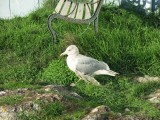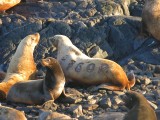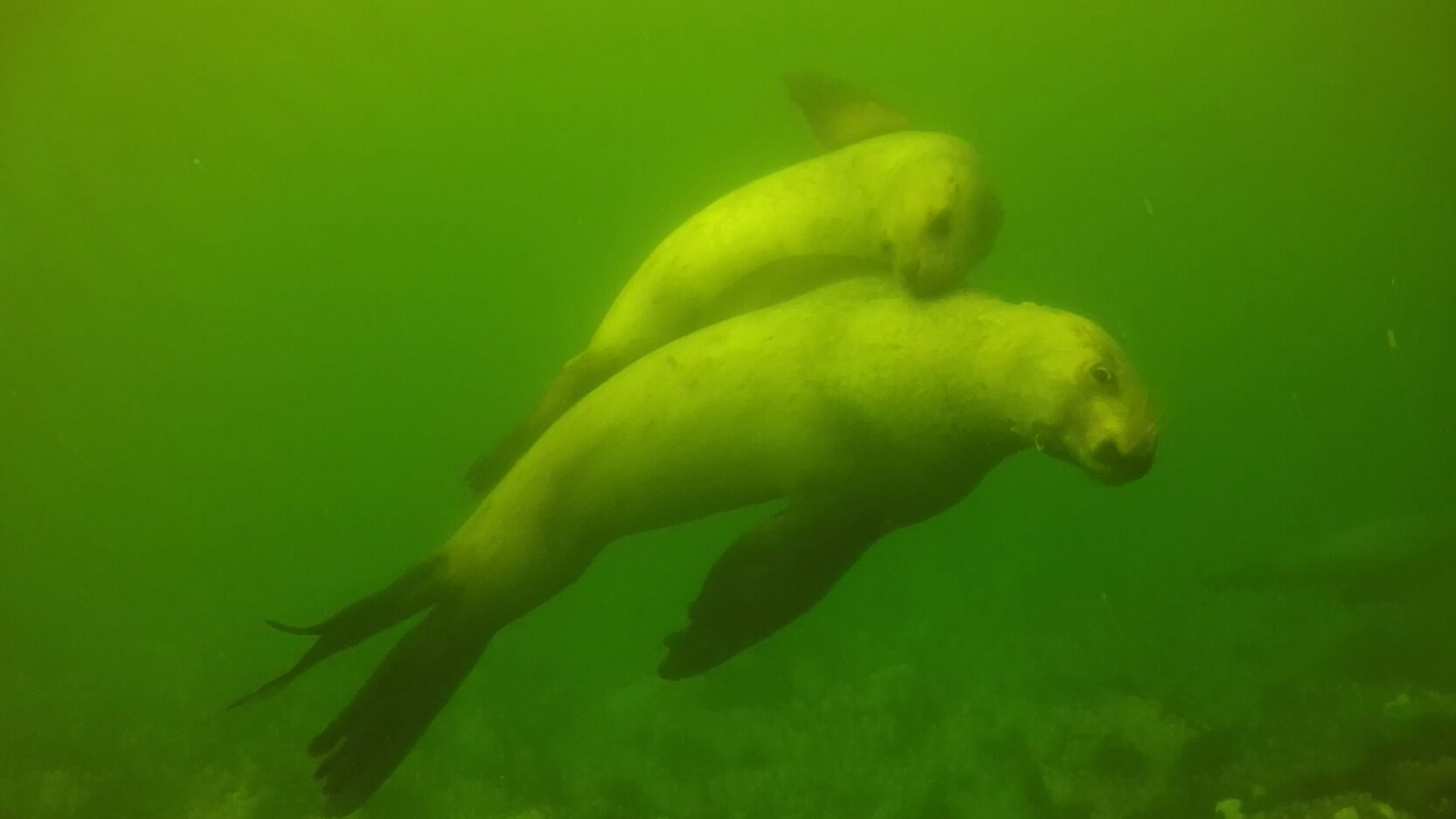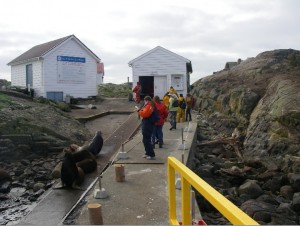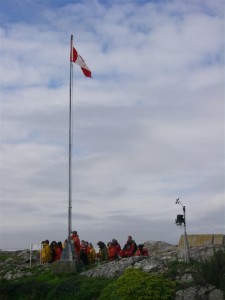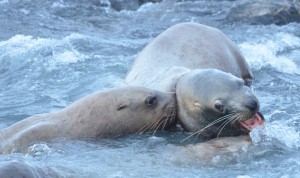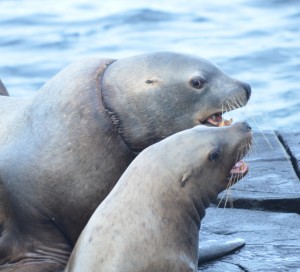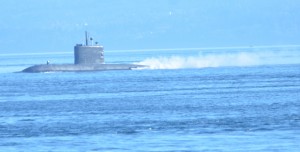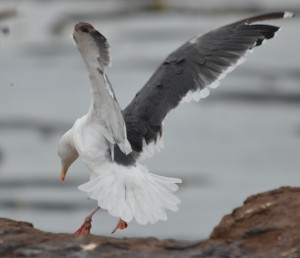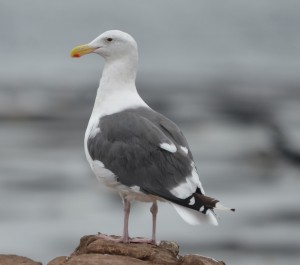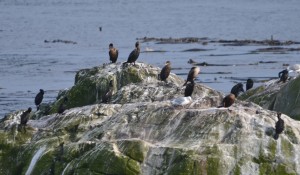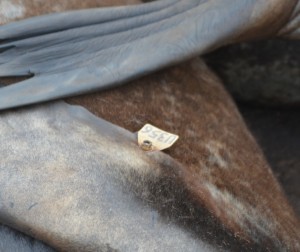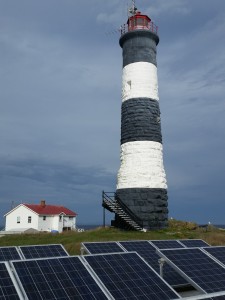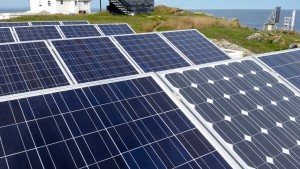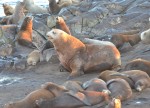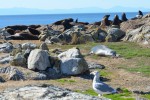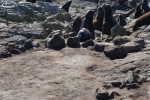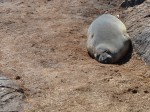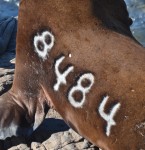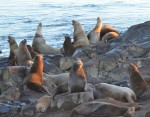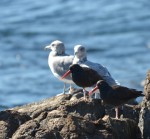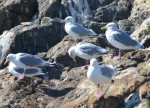In preparing for the oral presentation that the Friends of Ecological Reserves will give on January 28 in Burnaby, as an intervenor for the National Energy board Hearings, I have recently updated or graphs on Humpback and Orca sightings by the Ecoguardians at Race Rocks: The posts done by our Ecoguardians tagged for orcas or humpback whales assisted in this tabulation.
Tag Archives: Orca
Godwit and Guillemots
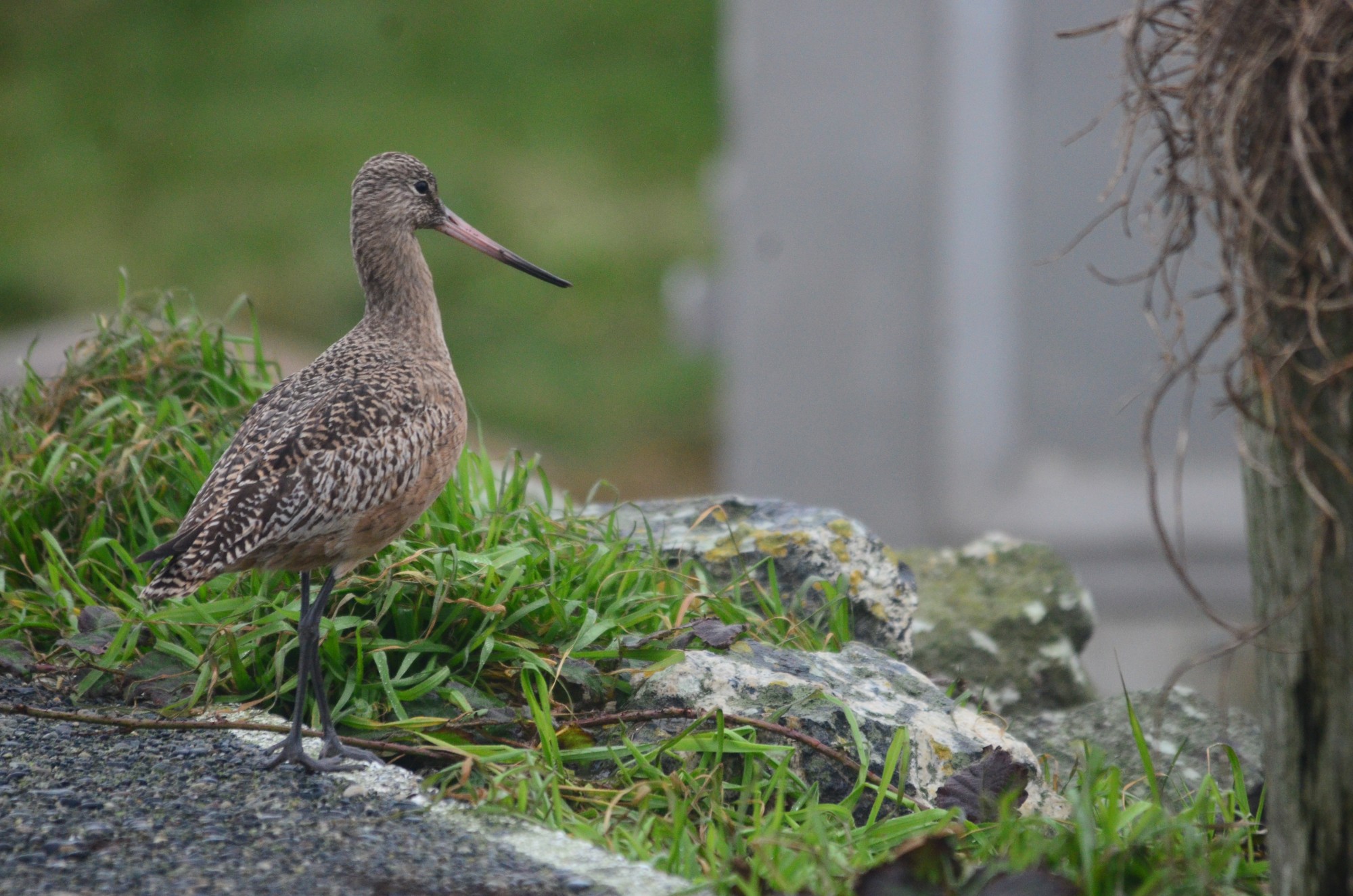
Marbled Godwit
Ecological Happenings
- Calm overcast day with light winds and settled seas.
- Allot of driftwood and deadheads floating past in the current around the rocks from the storms and high tides of late.
- Marbled Godwit spotted on the main island in the afternoon.
- Pigeon guillemots and Surf scoters observed around the main island to the North and East.
- The female Elephant seal remains on middle rocks, while the males and smaller Elephant seal remain on the main island.
- Pod of Orca seen passing to the south, feeding in the straight. Approximately five in group consisting of males (larger dorsal fins), female and a calf. Group of accompanying birds (gulls and cormorants) circling and highlighting their position.
Marine Vessels
- One Whale Watching boat through the reserve.
- Courtney visited on 2nd Nature, from Pearson College, dropping off the winter fuel and a set of repaired steps for the jetty.
Maintenance
- Steps and fuel unloading from 2nd Nature.
- General tidying and preparation for end of shift.
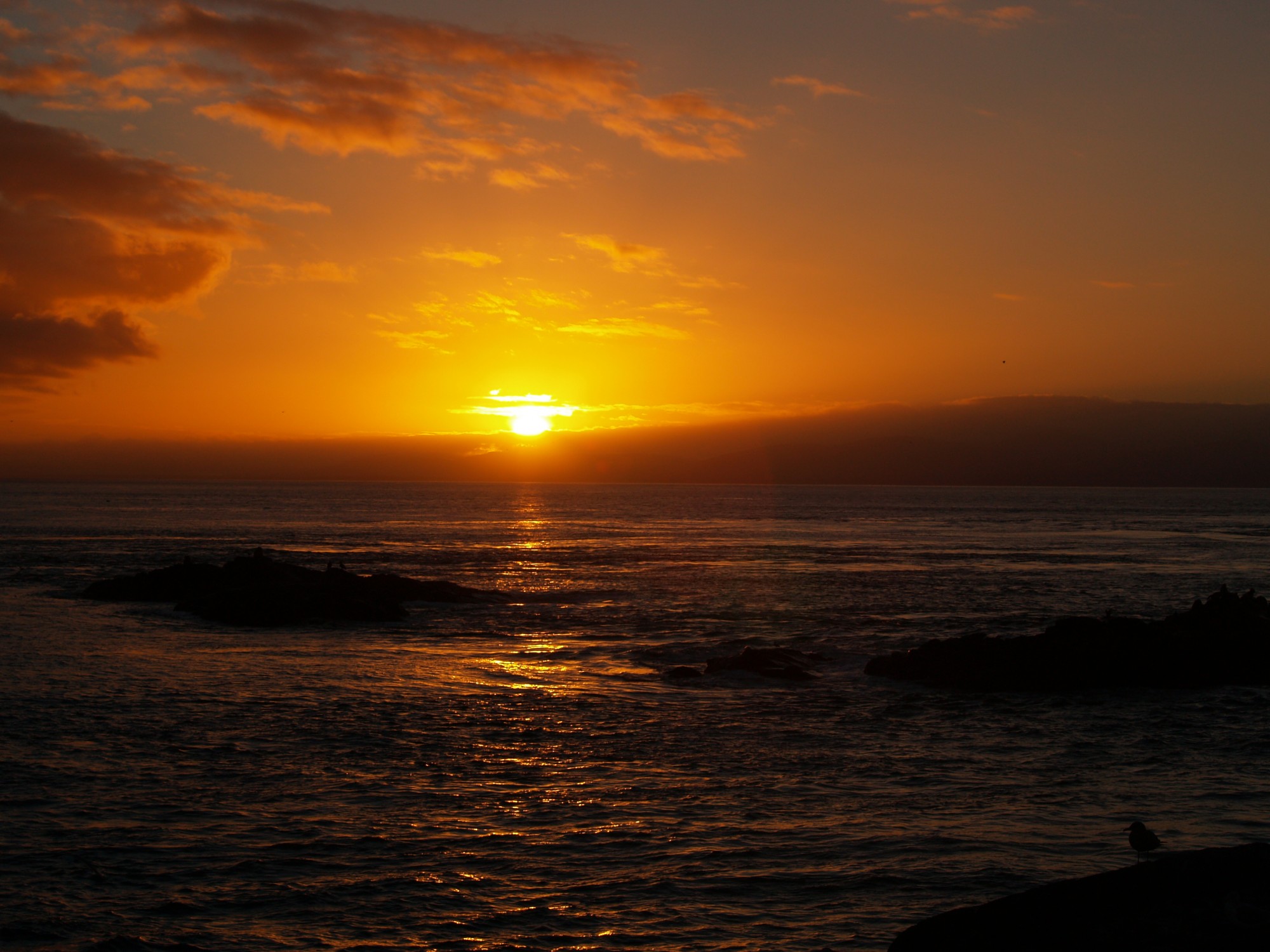
Cracking Sunrise
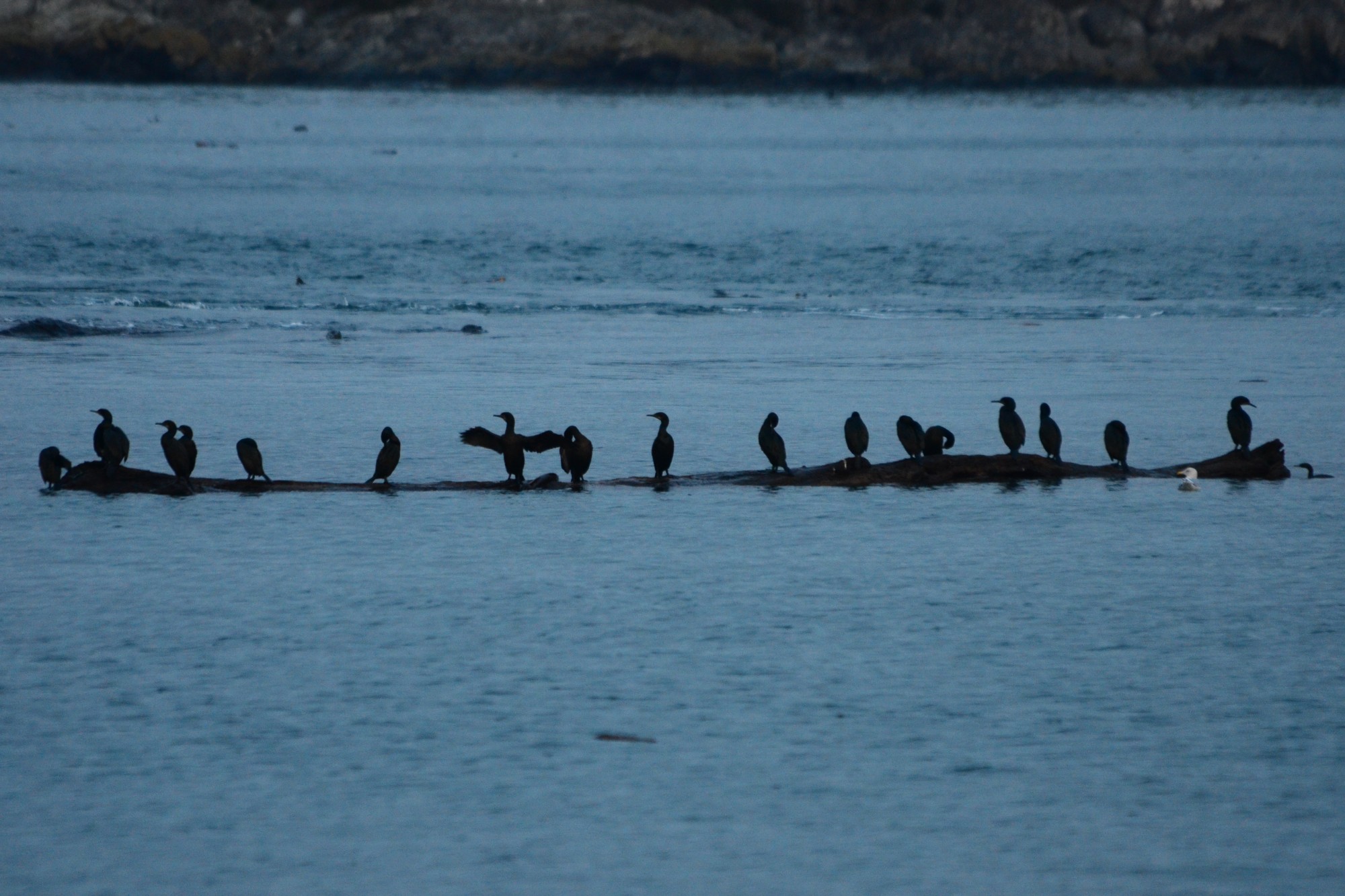
Cormorants taking a rest on some drift wood
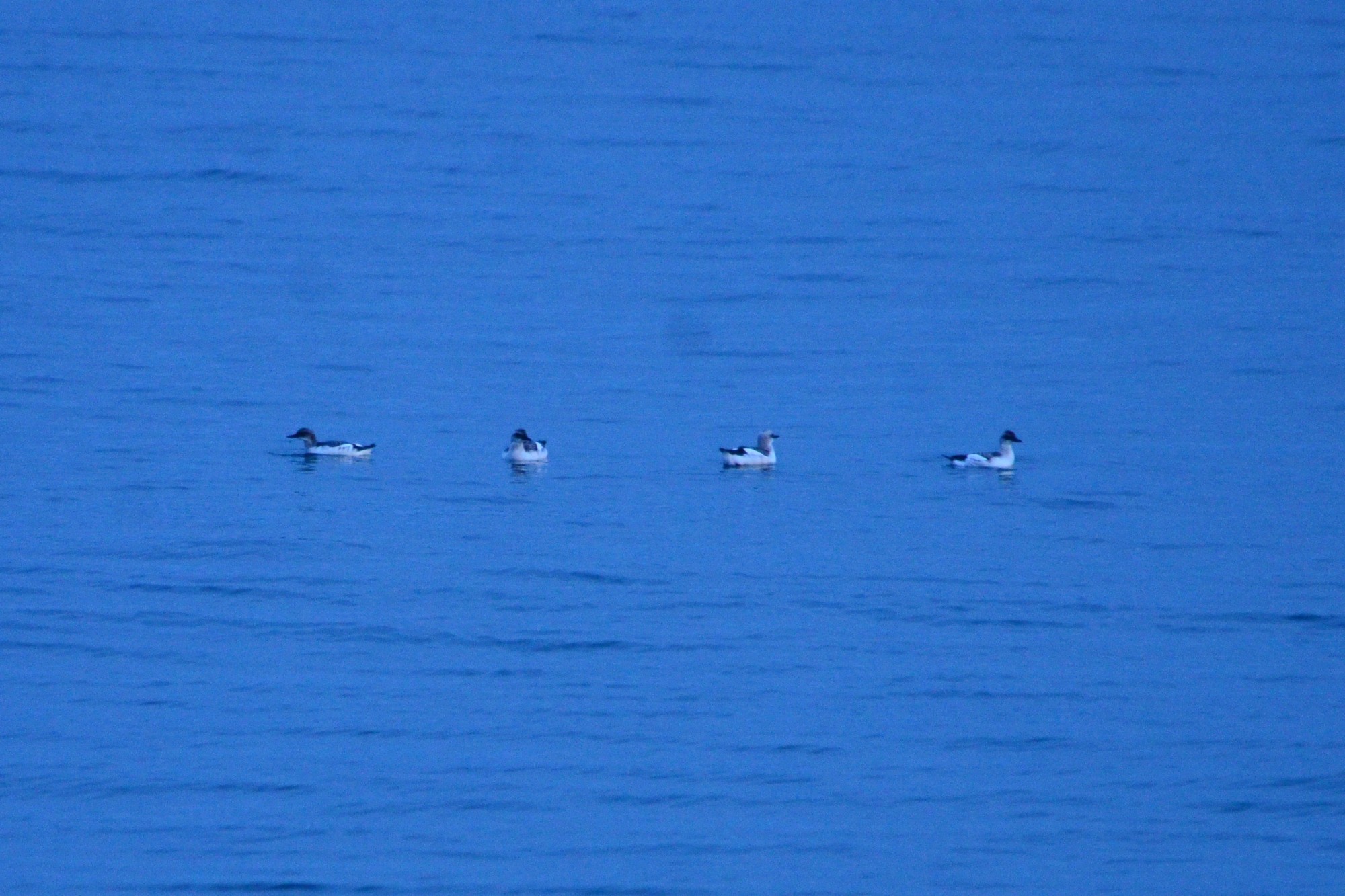
Pigeon Guillemots
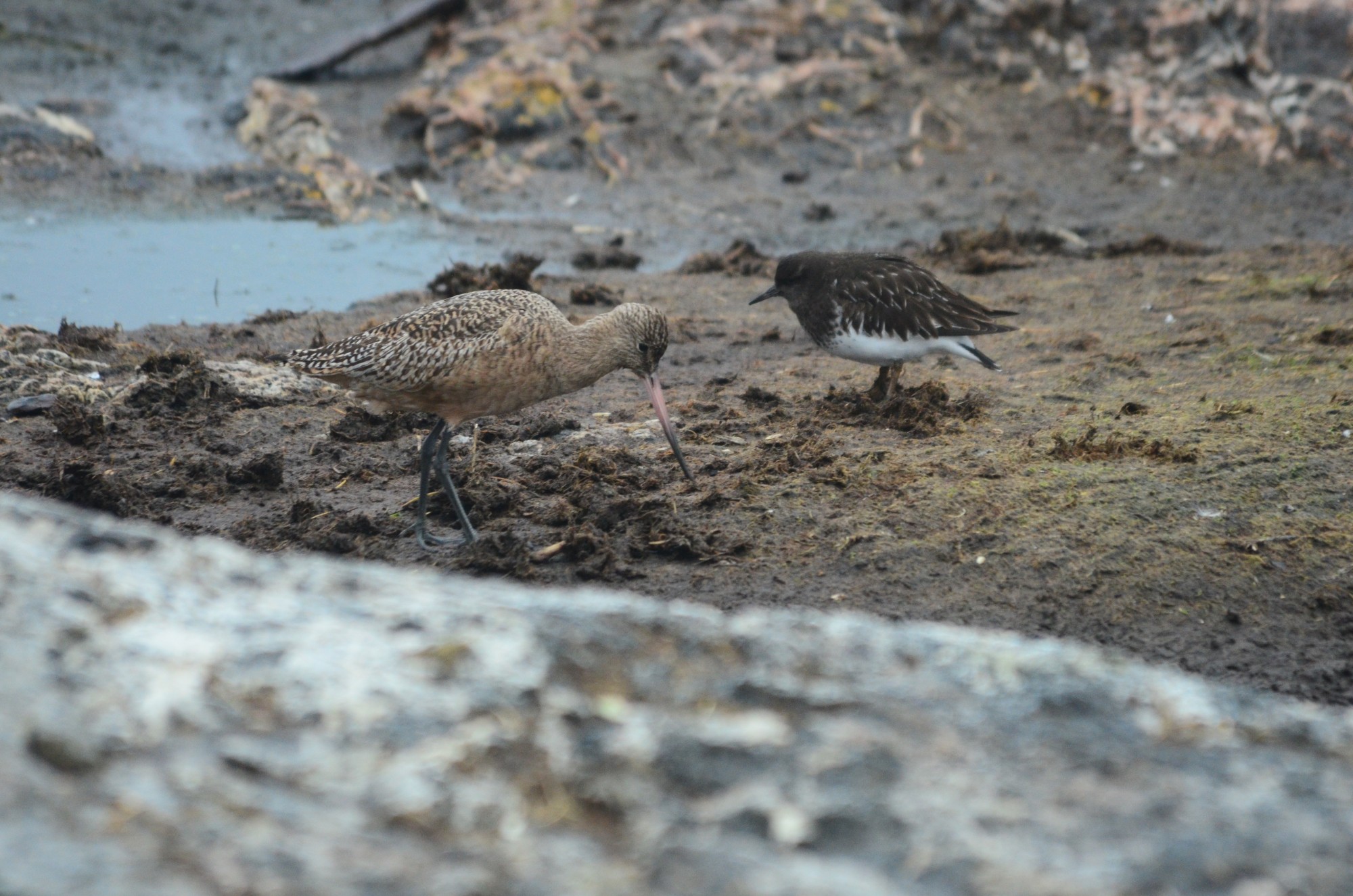
Marbled Godwit and Black Turnstone feeding
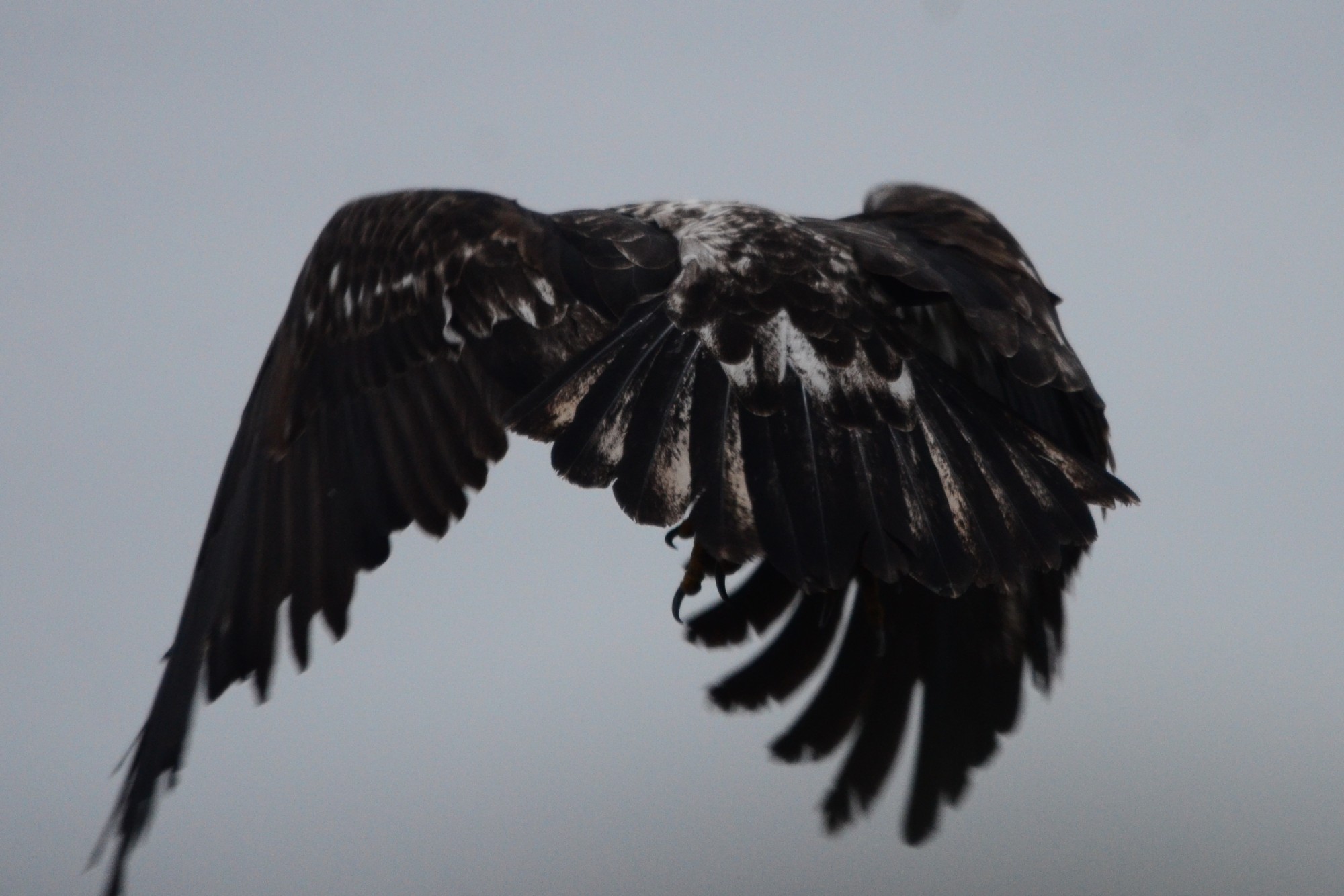
Immature Bald Eagle landing. Beautiful plumage.
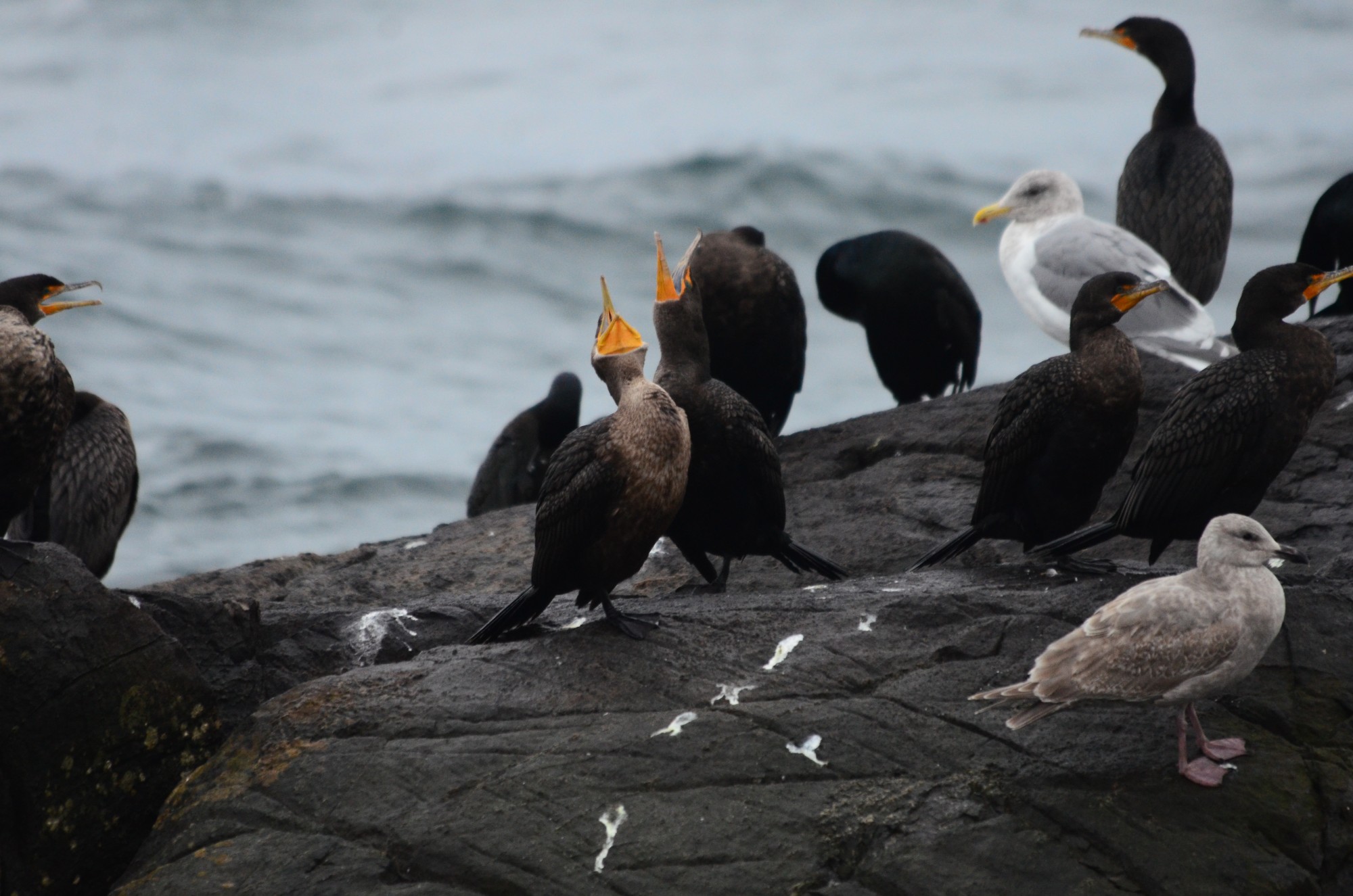
Double-crested Cormorants and Thayer’s Gulls
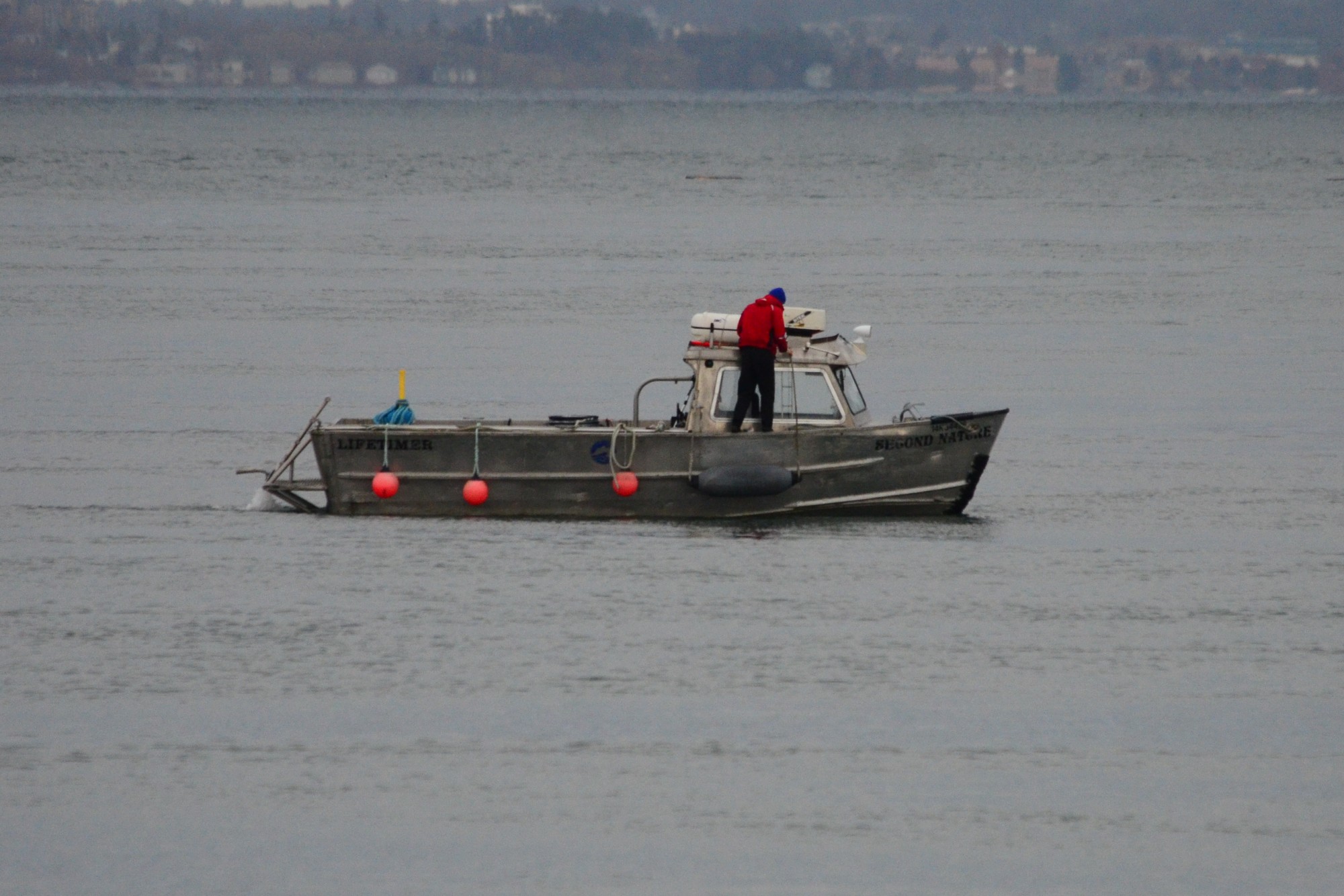
Courtney prepping 2nd Nature to come into the jetty
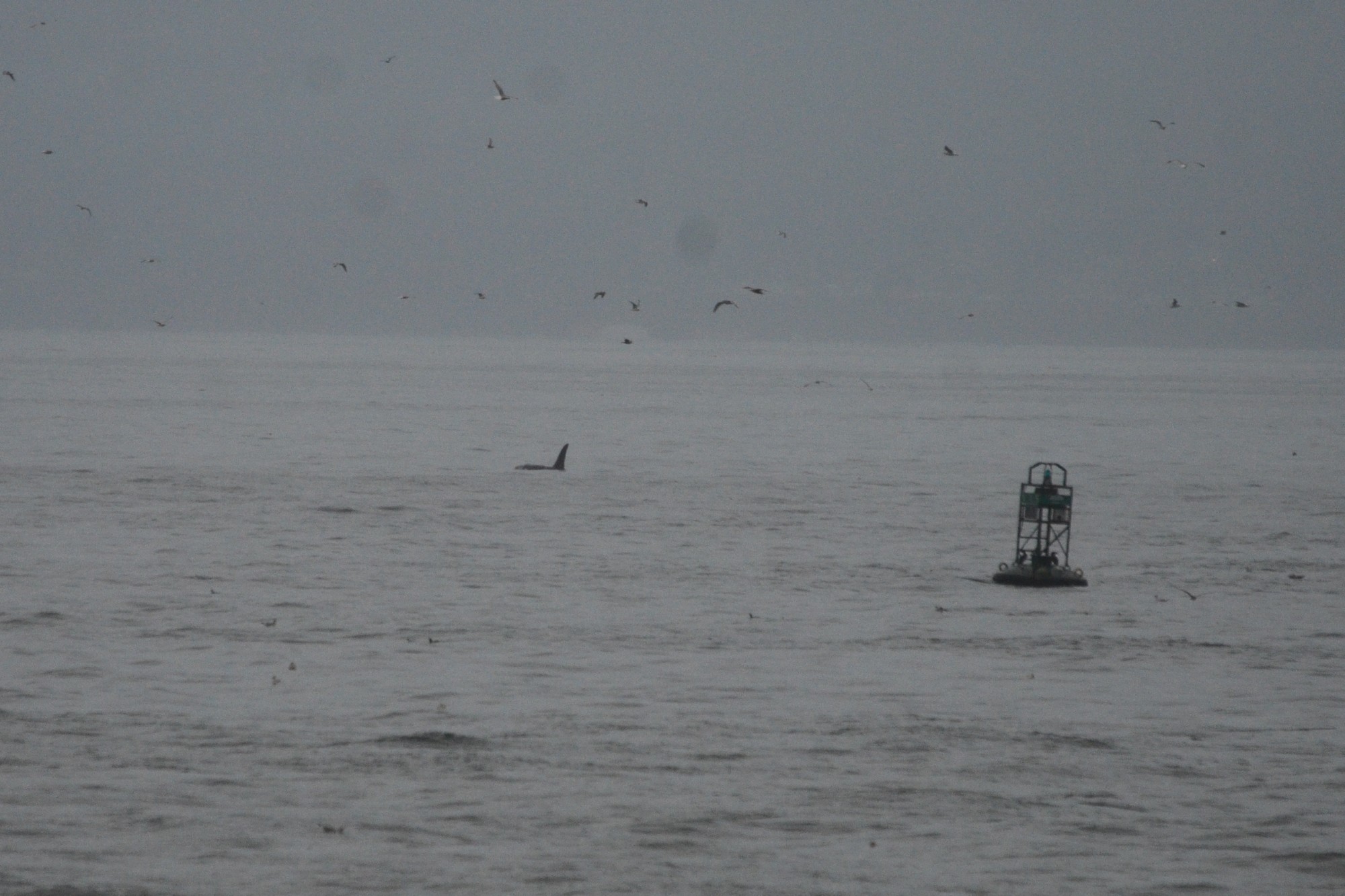
Male Orca in strait
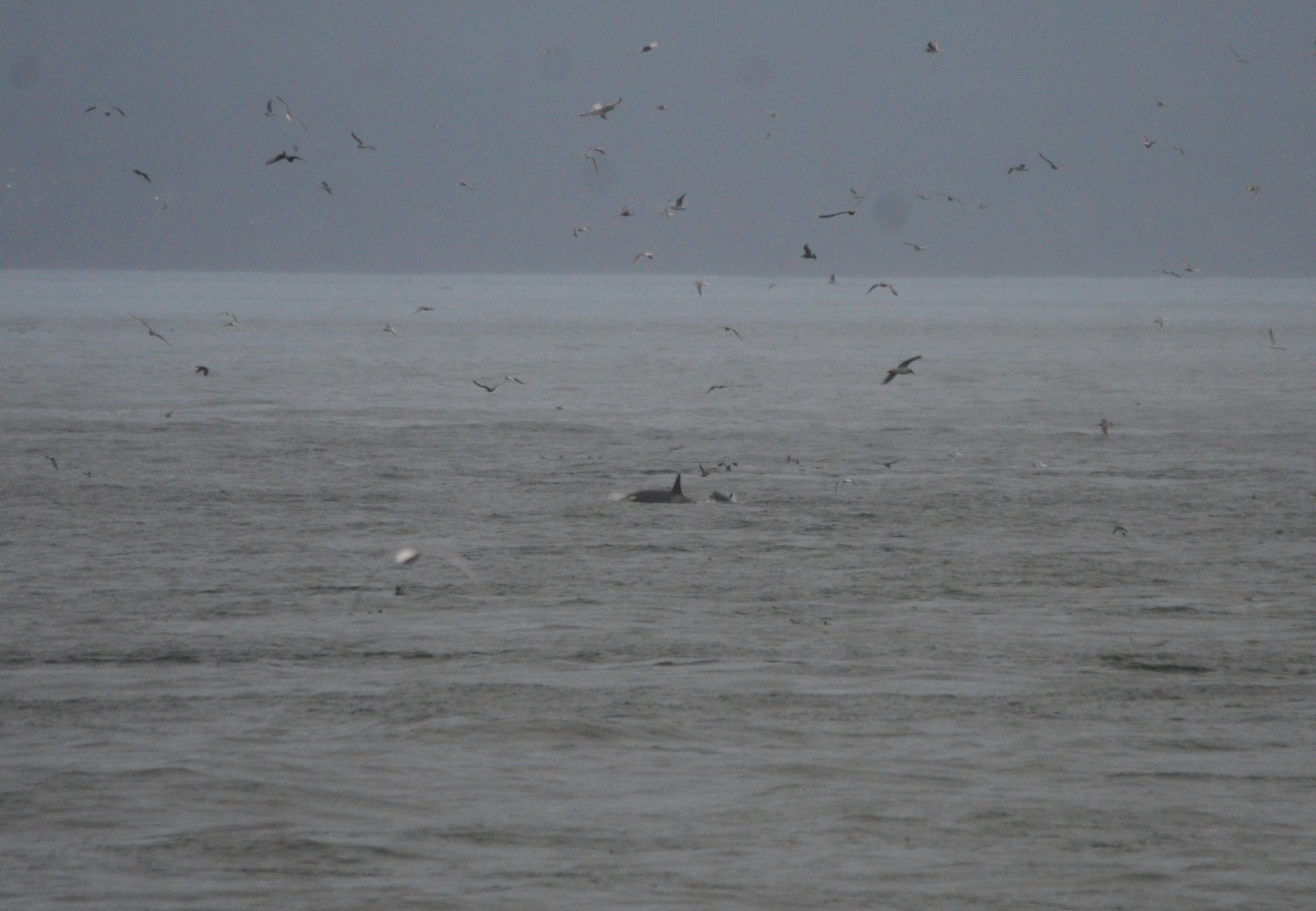
Female Orca and calf
Animal Census
| Steller Sea Lion | 218 |
| California Sea Lion | 231 |
| Harbour Seal | 7 |
| Elephant Seal | 4 |
| Cormorant | 297 |
| Gull | 773 |
| Spotted during the week | |
| Pigeon Guillemont | 6 |
| Bald Eagle | 4 |
| Sparrows | 10 |
| Surfbirds | 7 |
| Oyster Catcher | 15 |
| Black Turnstone | 12 |
| Raven | 2 |
| Harlequin Duck | 15 |
| Whales | 8 |
Early Morning Orcas
Weather
A fine day out at RR today. Winds of between 5-12 kts in varying easterly directions. The barometer dropped from 102.4 this morning to 101.9. Winds increasing tonight to up to 20kts, with midnight fog, forecast to dissipate by Saturday morning.
Boat activity
- Six tour boats (3 of which spotted the Orcas that were hanging around the reserve this morning)
- Two pleasure fishing vessels. One moved a little too quickly out of the reserve. We encourage all vessels to travel at a maximum of 7kts within the reserve (we don’t want butchered Sea Lions :)
Ecological happenings
- 3 Orca’s spotted well within the reserve this morning at 10am.
- Two bald eagles at North Rocks
Maintenance
- We continue to trouble shoot the water system in the student house. The pump is now installed, but there is a mysterious leak. Stay tuned……
Visitors
- Two friends of the eco-guardians are visiting the island today (Carole and Flo). One is a renewable energy consultant and will be checking out the island’s system for improvements. Like all visitors they are awestruck by the island’s energy and beauty.
- Orca!
- Elephant Seal
- Broken wing seagull
- Brand
New Eco-guardians.
It was a beautiful day at Race Rocks, with light southeast winds and a mostly clear sky. The barometer fell a little today to ~1013hPA and the forecast for tomorrow is for sunny skies. There is a strong wind warning in effect for overnight with diminishing southeast winds Friday. Rain is forecast for Saturday.
Only four whale-watching vessels were noted in the protected area today and three pleasure craft passed through going slowly. The people on one of those vessels, the Kaos were observed feeding rockfish to sea lions in the Ecological Reserve. It is illegal to feed wildlife and if it happens they will be reported.
Today was animal census day and here are the results.
Animal Census
Steller Sea Lion 321
California Sea Lion 637
Harbour Seal 77
Northern Elephant Seal 9
Sea Otter 0
Humpback Whale (1 observed within one mile of ER southeast of
Great Race)
Canada Goose 23
Harlequin Duck 5
Surf Scoters 11 (flying through to east)
Common Murre 5
Rhinoceros Auklet 4
Double-crested Cormorant 73
Brandt’s Cormorants 25
Pelagic Cormorant 9
Unidentified Cormorants 20
Bald Eagle 1 adult
Black Oystercatcher 11
Black Turnstone 7
Kildeer 2
Glaucous-winged Gull 248
California Gull 3
Thayer’s Gulls 707
Herring Gull 0
Ring-billed Gull 1
Western Gull 2
Heerman’s Gull 14
Mew Gull 0
Unidentified gulls 53
Total gull count 1028
Common Raven 2
Red-winged Blackbird 7 (during count week)
Savannah Sparrow 12
Song Sparrow 2
American Goldfinch 1
American Pipet 1
Don and Nina, the new eco-guardians in-training arrived today. They worked hard all day, after getting up very early to catch the morning slack and are progressing really well in learning some of the idiosyncrasies of Race Rocks operations.
Steaming Up the Strait?
After an overcast and partially foggy start to the day, the sky cleared in the early afternoon. Winds were less than 10 knots all day from the west-southwest turning to east in the evening. The barometer rose slowly all day and reached ~ 2022h PA. The forecast is for light winds becoming easterly 10 to 15 knots early Wednesday morning. It is expected to clear in the morning and be nice on Thursday.
Only four whale watching vessels were observed in the protected area today. They all treated the protected area with respect and drove slowly and carefully. Several pleasure craft went through, one at high speed, right through the area where there were 50 to 100 sea lions in the water. The other sports fishers were much more careful.
A couple of miles to the south of Great Race, a Canadian sub was observed heading out to sea and then a few minutes later, literally steaming back to shore.
I had the opportunity to work with one of Catrin Brown’s first year biology students today. They have just finished studying ecology, so came well armed with vocabulary and concepts and were keen to soak up knowledge gained firsthand on this little biological hot-spot.
We saw evidence of food chains and food webs everywhere from Canada Geese grazing on the grass, to evidence of predation on gulls and predation by gulls. We observed the thick climax kelp forest that rings the islands and reefs and saw evidence of intertidal grazers like chitons and phytoplankton feeders like clams and mussels. We didn’t spot the sea otter that is usually here but had plenty of other marine mammals and evidence of their dining and moulting habits in the form of fish bones, fish otoliths and hair, fur and pelage (from the spring moult of the Northern Elephant Seals).
We talked about the trophic level of different types of Killer Whales and the need for protection of critical habitat for recovering species at risk. The southern Resident Killer whales are of course highly endangered and are really dependent on strong Chinook Salmon runs while Biggs Killer Whales feed one trophic level up and eat marine mammals like seals and sea lions that in turn eat salmon.
We talked about the timing of births, mating, nursing and parental care in different species and about different symbioses including parasitism ( nice worms present in seal poop) and mutualism. We talked about phenology and seasons being dominated by different types of fish and about migrations.
We even touched on the great detritivore and decomposition loops. The carbon sink that is mediated by the microbial pump that transfers carbon to deep sediments. It was an ecologist’s kind of an afternoon, a living show and tell, a time for discovery and questioning which will hopefully on reflection, lead to some deep learning.
- Pearson College Biology students head up the jetty past California Sea Lions and Northern Elephant Seals.
- Pearson College Biology students from around the world gather under the Canadian flag at Race Rocks to start their ecology field trip on Great Race Island.
- The larger sea lion is “necklaced”, that is he has a plastic strap around his neck and it is embedding into his flesh. Two small animals were observed in close contact appearing to try to help. This animal is here daily near the house and is a good candidate for humane removal of the strap by Dr. Martin Haulena and team from the Vancouver Aquarium.
- Kettle’s on.
Chores were routine and it is great to have company.
Twofold Foggy: Friday – Saturday
Friday started with fog again and light southeast winds, from 5 to 10 knots. By late morning there were glimmers of clearing and by mid-day the sun was shining. The wind stayed calm and it stayed fairly clear, with clouds rolling by as the wind turned to west, in the late afternoon. By evening it was still and the sky mostly clear but that must have changed as the was fresh rainwater in the morning. The barometer bottomed out Friday morning at 1007 hPA before rising briefly. It started to drop again mid-day falling until mid-Saturday. The gale warning for Saturday, came true after another very foggy morning and light easterly winds. The turn to westerly was rapid, the fog was blown off and ominous clouds with a black line on the water to the west, foretold of what was to come. It blew up fast, reaching 40 knots and then settled back down to the up and down of 20 – 35 knots. There is gale warning is still in effect and the wind is forecast to lighten overnight, then become easterly 5 to 15 near noon Sunday. (I am collecting rainwater for laundry, bonus.)
Only two whale watching vessels were observed in the protected area Friday. Two sports fishing vessels also passed through. Saturday was a little busier with five whale watching vessels noted in reserve but there were no pleasure craft, they were probably seeking shelter. It is quite possible that I missed traffic both days due to thick fog reducing visibility.
Thursday was too foggy to do the animal census so it is cobbled together from the brief time slots when visibility permitted on Friday. It is interesting to note that the gull population plummeted after the arrival of the first Bald Eagle to be seen here, since I arrived at the end of August. Not sure if that is coincidental or not.
I only noticed the eagle because of the hundreds and hundreds of gulls moving en masse, from North Rock over to Great Race. When I peeked through the spotting scope, all the cormorants were in the water, the gulls were gone and there sat an adult Bald Eagle. Only the Harbour Seals seemed to ignore its presence.
There was no sign of the eagle today and the gull numbers are perhaps even lower. Glaucous-winged juveniles and adults continue to mill around summer territories. Some young ones are still practising picking things up, flying up and dropping them. Most of the adults are fully into their alternate plumage now. Their faces recovering from the physical aspects of feeding young.
The sea lions are spending more time in the water now that their favourite haul-out spots are worse than pig pens. Some of them have turned to rock climbing and I saw the first scouts up on the heli-pad today.
Animal Census
Steller Sea Lion 317
California Sea Lion 428
Harbour Seal 156
Northern Elephant Seal 6
Sea Otter 1
Southern Resident Killer Whale ( observed within one mile of ER during count week, (Race Passage, east, west and south of RR)
Biggs Killer Whale (Transients) ( during count week Race Passage & southwest)
Humpback Whale 2 (1 observed within ER west side during count week)
Minke Whale 1 ( observed within one mile of ER during count week just east of North Rock)
Canada Goose 4
Harlequin Duck 7
Surf Scoters 73 (flying through to east)
Double-crested Cormorant 35
Brandt’s Cormorants 29
Pelagic Cormorant 9
Bald Eagle 1 adult
Black Oystercatcher 23
Black Turnstone 6
Kildeer 2
Glaucous-winged Gull 258
California Gull 41
Thayer’s Gulls 874
Herring Gull 0
Ring-billed Gull 0
Western Gull 2
Heerman’s Gull 20
Mew Gull 18
Unidentified gulls 361
Total gull count 1574
Common Raven 2
Savannah Sparrow 19
Fox Sparrow 1
Junco 1
Golden-crown Kinglet 1
American Pipet 1
Starting the countdown on my last week on the rock for this shift. I may be back for a bit at the end of October, if extra training is needed for the new folks.
Noticeably Darker Day
Today was more of a fall day with cooler temperatures and a threat of rain in the air. Light levels were way down too. The barometer rose to 1014 hPA from a low of 1010 yesterday and it has just started to fall again. Rain and east winds of up to 25 knots are predicted to bring tomorrow’s forecasted rain, with a cool, wet outlook for the week ahead.
Thirteen visits to the protected area, by whale watching vessels, were observed today. Only one pleasure craft was noted.
There was a lot of cetacean action in and around Race Rocks for most of the day. It started with two big, bull, Biggs Killer Whales (Transients), travelling in from the west on the Rosedale side. They were later spotted in Race Passage and not long after an adult female Killer Whale was seen well inside the reserve by Turbine Rock. There were two Humpback Whales, one feeding just east of Race Rocks that moved west through Race Passage. It had a definite white splotch on the right fluke. The other one was feeding just west and had dark flukes, the same one, I think, that has been around for a while. There was also a Minke Whale feeding just to the south of Race Rocks.
Accumulated solar radiation levels today were less than half of what they have been for the last few days, 150 versus 300 to 350 Langleys and the days are getting noticeably shorter, faster now. Migrant species are moving through the reserve daily with hundreds of Surf Scoters moving through from west to east every day. All three species of cormorants are using the rocks here as roosts now and feeding in the multi-species flocks that surround the reserve with much commotion. This change into autumn not only impacts the biodiversity of the reserve but also has an impact on practical things like power generation.
Solar power has been producing over 90% of the power needed to run everything on the island and that amount will change over the next few months. Right now the shortfall is made up with a diesel generator but the plan is to move to cleaner burning propane in the near future. A great deal of progress has been made in reducing the amount of fuel stored and used here, from the days of the Coast Guard when there were six giant diesel tanks dominated the rock and the generators ran 24/7. A big shout goes out to Pearson College, for both reducing the ecological footprint in terms of CO2 and for reducing the risk of a spill.
- Western Gull landing.
- Western Gulls are much darker than the Glaucous-winged Gulls that nest here. The two species can hybridize which makes identification challenging sometimes.
- All three species of cormorants can be seen here, if you look carefully.
- This California Sea Lion’s tag U359, matches the brand which is not always visible.
- Old technology and new.
- Race Rocks operations depend on the sun for electricity.
Gathering of the Gulls
Today started fairly clear, then clouded over. In the afternoon it was sunny for a few hours and eventually the sky darkened and at dusk the rain started. The barometer rose to almost 1019 hPA mid-day and then fell. The forecast is for clearing and light east winds with sunshine on the horizon.
Twelve commercial whale-watching vessels were observed working in the Ecological Reserve. They were in the area watching a Humpback feeding very close to the western reserve boundary, transient orcas to the southwest and southern resident killer whales to the northeast.
Today was census day due to thick fog yesterday.
Animal Census
Steller Sea Lion 338
California Sea Lion 908
Harbour Seal 178
Northern Elephant Seal 5
Sea Otter 1
Southern Resident Killer Whale (26 observed within one mile of ER during count week, (Race Passage, east, west and south of RR)
Biggs Killer Whale (Transients) (9 during count week Race Passage & southwest)
Humpback Whale (3 observed within one mile of ER during count week)
Minke Whale (1 observed within one mile of ER during count week just east of North Rock)
Canada Goose 20 attempting to be full time
Harlequin Duck 5
Surf Scoters 30 (flying through to east)
Double-crested Cormorant 12
Brandt’s Cormorants 27
Pelagic Cormorant 5
Black Oystercatcher 5
Black Turnstone 7
Surfbirds 13
Kildeer 2
Total gull count 2469
Estimated numbers
Glaucous-winged Gull 350
California Gull 50
Thayer’s Gulls 1500
Herring Gull 1
Ring-billed Gull 1
Western Gull 1
Heerman’s Gull 15
Mew Gull 20
~531 unidentified gulls
Common Raven 2
Savannah Sparrow 10
Fox Sparrow 2
Song Sparrow 2
Junco 3
Pacific Wren 1
Other chores were routine. There were no visitors.
Sumo-sized Sea Lions
It was a copycat kind of day, weather wise, the same as yesterday and the day before. Calm, very light winds and clears skies. The barometer continued the drop started on Sunday and is now below 1012 hPa again. The forecast is calling for a switch to light winds west 10 -1 5 and a mix of sun and cloud until Friday when showers are expected..
Whale watching traffic in the Ecological Reserve was fairly light with only eight observed visits. All the operators did really well today. They slowed on entry, went with the current, drove in a responsible way that respected the protected area and saved speeding up until they were clear of the reserve. This is the sort of cooperative behavior that is the norm for sustainable operations in reserve. Observations were made of “sports” fishers hauling in lingcod and rockfish in the Race Rocks Rockfish Conservation area.
Although there may have been more elsewhere, there was no lack of whale action around Race Rocks today. Three Biggs Killer Whales were spotted travelling from east to west through Race Passage in the morning and a Humpback Whale went the other way, in the afternoon, spending some time feeding close to North Rocks. There large multi-species feeding flocks in the same area. Perhaps there are balls of forage fish there.
I saw a large kelp raft, first of the season, sweeping out to sea with the ebbing tide today. This annual kelp becomes more and more prevalent in the tidelines as autumn progresses and the winter storms will remove most of it before spring. It is a great carbon sink that fixes large amounts of carbon, which will eventually become entombed on the bottom. Not all of it goes out to sea and sinks though. Kelp that lands on shore is a key part of near shore food webs relying on this large volume of rotting biomass to fuel new generations of shore spawners and out going young salmon.
Chores were routine again and the sunshine is allowing for recovery of freshwater lost earlier in the month. The level is almost back up to where it was on September 5th. There were no visitors.
- Race Rocks is a protected area and these boaters have been here before slaying the very fish the Rockfish Conservation Area is designed to protect.
- Fishing for rockfish in a Rockfish Conservation Area.
- This is an exceptionally large Stellers Sea Lion.
- Two Northern Elephant Seals decide the cairns are a good place to sleep too.
- Damage to vegetation around rock cairn archeological site. Culprits retreating to rocks.
- Northern Elephant Seal #5850 doesn’t notice that his noisy neighbours have left.
- No problem reading this California Sea Lion brand.
- “Necklaced Stellers Sea Lion visible top left.
- Two BLOY, two CAGU and one THGU
- Two Black Oystercatchers and a couple of California Gulls rest together on south side of Great Race.
- Thayers Gull (left), roosts with California Gulls and Black Oystercatchers on south side of island.
- Thayer’s Gulls are becoming ubiquitous.


